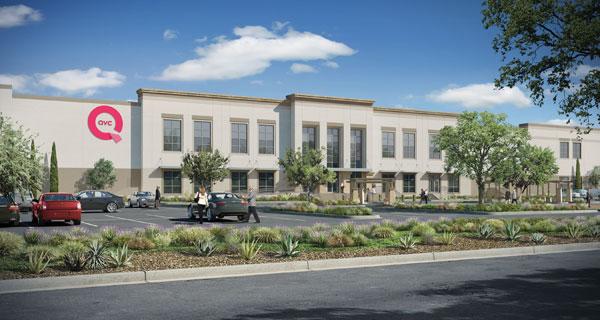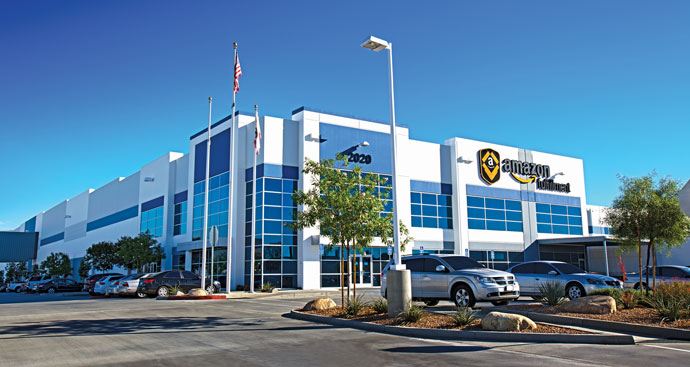When two of the world’s largest retailers select the same county for massive distribution and e-commerce fulfillment centers, the news tends to command the attention of other site selectors.
Such was the case when Walmart and QVC each chose San Bernardino County in inland Southern California for 1-million-sq.-ft.-plus distribution facilities earlier this year.
Walmart, No. 1 on the Fortune 500 list with $485 billion in annual revenues, selected Chino for a 1.2-million-sq.-ft. e-commerce fulfillment center that will bring up to 200 full-time jobs to the area.
QVC, the world’s largest TV and ecommerce retailer with $8.8 billion annually in sales, picked Ontario for a 1-million-sq.-ft. distribution center that will employ more than 500 workers by 2018 and about 1,000 workers by 2020.
Together, the two projects comprise one of the biggest capital investment surges that San Bernardino County has recorded in its history. They also come on the heels of significant investments made by Amazon into its own state-of-the-art e-commerce fulfillment centers in San Bernardino and Redlands, among other cities.
In the case of QVC, the project represents the Pennsylvania-based company’s first distribution center on the West Coast.
“The first site selection factor was to identify the region of the country that optimized service to our customers,” says Jim Reid, vice president of distribution operations at QVC. “Once that was done, we conducted a pretty exhaustive search over several months. We looked at lot sizes, transportation access, available workforce and other factors involved in managing the building. We narrowed our search to the Ontario site because it was the best site for our organization.”
Upon completion in summer 2016, QVC’s new site in Ontario will rank as one of the city’s largest distribution centers and among its top employers. The lease deal signed in July with property owners Sares-Regis calls for the development of an approximately 1-million-sq.-ft. building in Ontario at Fourth Street and Vineyard Avenue just north of the Interstate 10 Freeway.
“Broadly, we looked at a number of major cities in Nevada, Arizona and California before choosing Ontario,” Reid tells Site Selection. “We eventually narrowed the list down to a few locations in Northern Nevada and the Inland Empire of Southern California.”
Incentives, Utility Rates Factor In
Incentives were a factor, but they did not drive the deal, he notes. “They were factored in,” he says. “It does change the dynamics of site selection. We qualified for $1.4 million in California Competes tax credits. They are performance-based. I’m sure we will meet the requirements. We also worked out an incentive with the city — for a portion of their sales tax revenue on all products QVC sells into the state of California. Both incentives were very important.”
Reid adds that QVC also worked with Southern California Edison to get discounted electric utility rates at the new plant. “It definitely helped our selection of this site,” he says.
A spokesperson for Walmart tells Site Selection that two factors drove the company founded and built by Sam Walton to choose Chino: proximity to customers and access to qualified workers.
“The location of this and Walmart’s other recently announced e-commerce fulfillment centers gives us easy access to the vast majority of our customers throughout the US,” says Ravi Jariwala, director of public relations for Walmart in San Bruno, Calif. “This center — along with others like it in Pennsylvania, Indiana, Atlanta and Texas — are part of Walmart’s larger and unique fulfillment network that consists of smaller e-commerce fulfillment centers, Walmart stores and distribution centers, and our world-class transportation fleet. The combination of assets gets us closer to customers and enables multiple options for fulfilling orders quickly and cost effectively.”

San Bernardino County’s history as a hub for logistics and transportation was a pivotal site selection factor, says Jariwala. “We’re excited to be part of San Bernardino County, a hub for US manufacturing, logistics and transportation for the past 50 years,” he says. “The local workforce is comprised of talented men and women who are looking for opportunities to work for great companies.”
Jariwala notes that the pay rate at the Chino facility will range from $13.50 to $16.75 an hour, depending on the job type, “with eligibility for progressive wage increases every six months.”
The county’s Workforce Investment Board is assisting Walmart in the hiring process by organizing and implementing job fairs to review hundreds of candidates in collaboration with Walmart’s human resource managers. “This is all at no cost to Walmart,” says Sandy Harmsen, executive director of the San Bernardino County Workforce Investment Board. “The goal is to hire local and benefit the Chino community. The WIB will continue to work with Walmart whenever a hiring need comes up.”
Both of these facility projects are happening at a time when the economies of Ontario and San Bernardino County are improving. From March 2014 to March 2015, employment in the transportation and warehousing-distribution sectors increased by 44 percent (1,500 jobs) in Ontario, according to the State of California Employment Development Department. In March 2015, these two sectors accounted for 25 percent of all jobs in Ontario. With 25,575 workers, these two sectors make up the largest employment block in the city.
Workers Bring Experience to the Job
Reid says Ontario’s labor quality attracted QVC. “It is important for us to find the right candidates,” he says. “QVC culture is very important to us. The Ontario area and San Bernardino County have a very attractive talent pool. It is a hub for transportation and distribution. That helps us with recruiting and screening and on-the-job training. Many of these workers have already trained in distribution. It made the deal even better.”
Reid calls the Ontario area “a real hot spot for industrial growth, especially in e-commerce distribution. The transportation network and the proximity to customers are excellent. The county is also an affordable place to have our employees call home. It is important to place ourselves where the employee can have a good work-life balance and afford to live.”

Reid adds that QVC “talked with a number of communities in both San Bernardino and Riverside counties. It really came down to the right site and the right proximity to our carriers and the right community. The Ontario site was the best across the board.
“We considered a few other sites as well,” he says. “The challenge is to find a good piece of land that can hold a 1-million-square-foot building. With the site we selected in Ontario, there is room to expand. The plot of land is maxed out for this size of building, but we are building this facility with room for internal expansion. When we cap out, we will do a network analysis. This is our first facility in California. We are looking at other countries. There is a planned expansion beyond our original footprint.”
Mary Jane Olhasso, assistant executive officer for San Bernardino County government, says the county continually invests into its transportation network to maintain its edge. Currently, the county has 31 transportation infrastructure projects representing $4.5 billion in ongoing development and construction projects.
“There is a major redesign of the intersection of I-15 and I-215 that will free up the transportation corridors,” Olhasso says. “It is a critical corridor for moving goods and people between Southern California and Las Vegas. That project is currently in design and right-of-way acquisition, and it is huge for this region.”
Olhasso says San Bernardino County is positioned to attract more high-profile employers such as Walmart, QVC and Amazon. “Our population base and young demographic and family formation will provide a high-quality workforce for decades to come,” she says. “We are much younger than the coastal communities. The migration of families moving to our area is strong. This is the culmination of the classic Southern California path of development away from the coast and toward the Inland Empire. This happens to be our time.”
The county’s Workforce Investment Board consistently wins awards as the best-performing workforce development program in the nation, notes Olhasso. “It is the model for workforce boards across the country,” she says. “Other states and counties send their boards to come visit us and learn what we are doing. The collaborative partnerships that we have formed for education and training are the best in the country. In fact, that is why the people who work on the Mars Rover live and work here.”
Chaffey College Plays Key Role
No one knows this any better than Kathy Dutton, director of employment development and community education at Chaffey College, one of the leading workforce training providers in the county. “Industrial jobs are very much alive in this county,” Dutton says.
In 2014, Chaffey and a consortium of nearby colleges, public workforce system partners and local manufacturers were awarded nearly $15 million toward development of an advanced manufacturing training program. The new Industrial and Technical Learning Center of the Inland Empire will fill a unique community need, and provide a strategic advantage for manufacturers and other employers by developing and retaining skilled craft employees.
“Overall, in advanced manufacturing, we will serve 2,600 students in the program. Our employer base is the Manufacturing Council of the Inland Empire, which has been in existence for at least 15 years and has more than 50 manufacturers as members.”
Dutton notes that “we meet with these employers every month and discuss curriculum and workforce needs. They come to the table with job openings that they anticipate they will have, and then we try to match that with job training. We provide hands on experience in robotics, electrical and mechanical work. These are good paying careers.”
She adds that “we match training with labor market forecasting. Our commissioners get out in the field and meet with employers and employees. We design training programs to fit the employer’s needs, a significant advantage for business attraction and retention.”
The new manufacturing center, set to open in early 2016, will be located on the campus of California Steel Industries in Fontana. It will focus on advanced manufacturing applications that include: industrial maintenance, including electrical and mechanical craft, pre-engineering/engineering, computer/IT training, machining, automation and robotics, metal fabrication/welding, as well as career readiness.
Dutton added, “This new training center is a unique opportunity to fill today’s workforce needs and ensure we are filling any skills gaps, while developing our next generation employee base with critical input directly from our local manufacturing employers.”
This Investment Profile was prepared under the auspices of San Bernardino County government. For more information, contact the county Economic Development Agency at 909-387-9801. On the Web, go to www.sbcountyadvantage.com.

